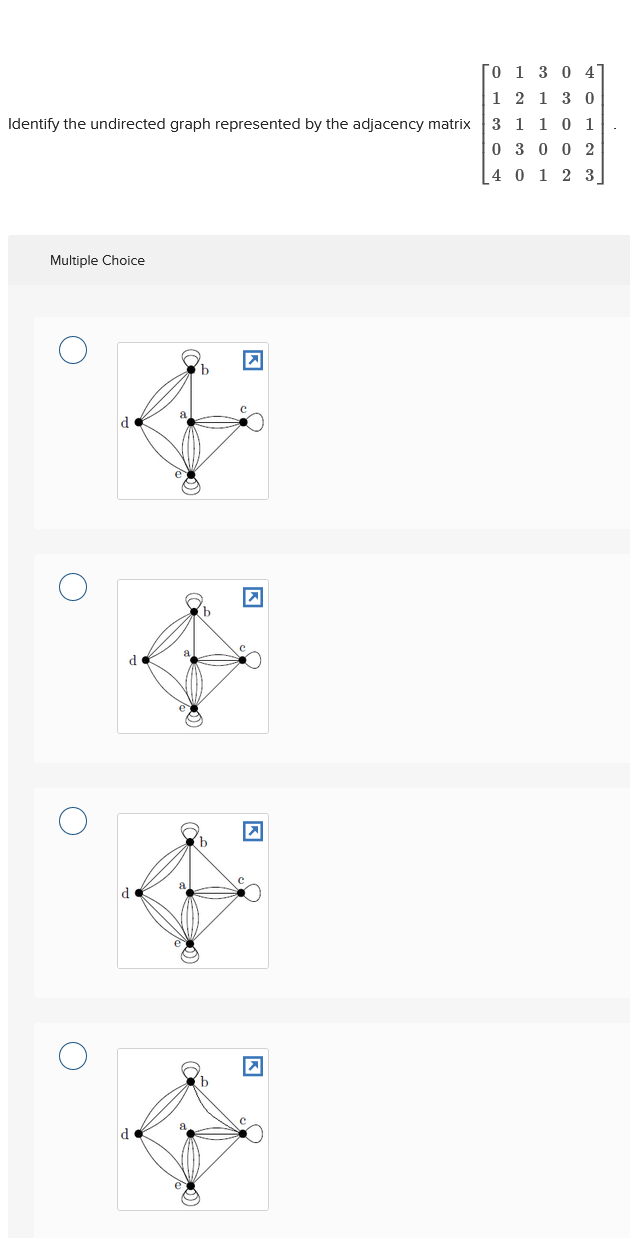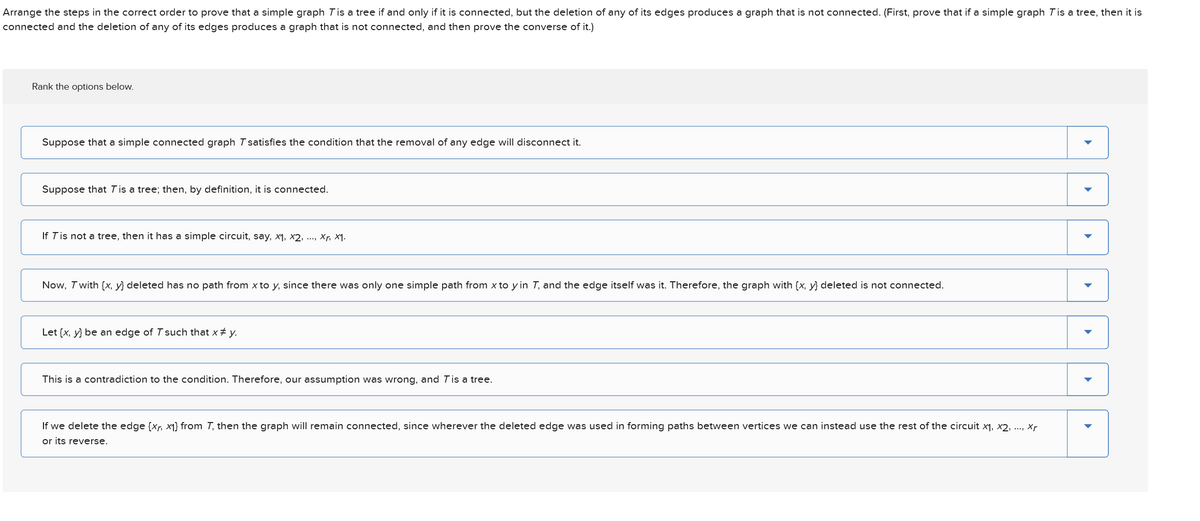0 1 3 0 4 1 2 1 3 0 Identify the undirected graph represented by the adjacency matrix 3 1 1 0 1 0 3 0 0 2 4 0 1 2 3 Multiple Choice о d d b d ☑ b Rank the options below. Suppose that T is a tree; then, by definition, it is connected. Arrange the steps in the correct order to prove that a simple graph T is a tree if and only if it is connected, but the deletion of any of its edges produces a graph that is not connected. (First, prove that if a simple graph T is a tree, then it is connected and the deletion of any of its edges produces a graph that is not connected, and then prove the converse of it.) Suppose that a simple connected graph Tsatisfies the condition that the removal of any edge will disconnect it. If T is not a tree, then it has a simple circuit, say, x1, x2,, xr, x1. Let (x, y) be an edge of 7 such that x * y. This is a contradiction to the condition. Therefore, our assumption was wrong, and T is a tree. Now, T with (x, y) deleted has no path from x to y, since there was only one simple path from x to y in T, and the edge itself was it. Therefore, the graph with (x, y) deleted is not connected. If we delete the edge (xr, x1) from 7, then the graph will remain connected, since wherever the deleted edge was used in forming paths between vertices we can instead use the rest of the circuit x1, x2, ..., xr or its reverse. ་ ་ ་ ་ ་
0 1 3 0 4 1 2 1 3 0 Identify the undirected graph represented by the adjacency matrix 3 1 1 0 1 0 3 0 0 2 4 0 1 2 3 Multiple Choice о d d b d ☑ b Rank the options below. Suppose that T is a tree; then, by definition, it is connected. Arrange the steps in the correct order to prove that a simple graph T is a tree if and only if it is connected, but the deletion of any of its edges produces a graph that is not connected. (First, prove that if a simple graph T is a tree, then it is connected and the deletion of any of its edges produces a graph that is not connected, and then prove the converse of it.) Suppose that a simple connected graph Tsatisfies the condition that the removal of any edge will disconnect it. If T is not a tree, then it has a simple circuit, say, x1, x2,, xr, x1. Let (x, y) be an edge of 7 such that x * y. This is a contradiction to the condition. Therefore, our assumption was wrong, and T is a tree. Now, T with (x, y) deleted has no path from x to y, since there was only one simple path from x to y in T, and the edge itself was it. Therefore, the graph with (x, y) deleted is not connected. If we delete the edge (xr, x1) from 7, then the graph will remain connected, since wherever the deleted edge was used in forming paths between vertices we can instead use the rest of the circuit x1, x2, ..., xr or its reverse. ་ ་ ་ ་ ་
Algebra & Trigonometry with Analytic Geometry
13th Edition
ISBN:9781133382119
Author:Swokowski
Publisher:Swokowski
Chapter9: Systems Of Equations And Inequalities
Section: Chapter Questions
Problem 19RE
Related questions
Question
Please help me with these three questions. I am having trouble understanding what to do.
How many vertices does a full 5-ary tree with 99 internal vertices have?

Transcribed Image Text:0 1 3 0 4
1 2 1 3 0
Identify the undirected graph represented by the adjacency matrix
3
1 1 0 1
0
3 0 0 2
4 0 1 2 3
Multiple Choice
о
d
d
b
d
☑
b

Transcribed Image Text:Rank the options below.
Suppose that T is a tree; then, by definition, it is connected.
Arrange the steps in the correct order to prove that a simple graph T is a tree if and only if it is connected, but the deletion of any of its edges produces a graph that is not connected. (First, prove that if a simple graph T is a tree, then it is
connected and the deletion of any of its edges produces a graph that is not connected, and then prove the converse of it.)
Suppose that a simple connected graph Tsatisfies the condition that the removal of any edge will disconnect it.
If T is not a tree, then it has a simple circuit, say, x1, x2,, xr, x1.
Let (x, y) be an edge of 7 such that x * y.
This is a contradiction to the condition. Therefore, our assumption was wrong, and T is a tree.
Now, T with (x, y) deleted has no path from x to y, since there was only one simple path from x to y in T, and the edge itself was it. Therefore, the graph with (x, y) deleted is not connected.
If we delete the edge (xr, x1) from 7, then the graph will remain connected, since wherever the deleted edge was used in forming paths between vertices we can instead use the rest of the circuit x1, x2, ..., xr
or its reverse.
་
་
་
་
་
Expert Solution
This question has been solved!
Explore an expertly crafted, step-by-step solution for a thorough understanding of key concepts.
This is a popular solution!
Trending now
This is a popular solution!
Step by step
Solved in 2 steps

Recommended textbooks for you

Algebra & Trigonometry with Analytic Geometry
Algebra
ISBN:
9781133382119
Author:
Swokowski
Publisher:
Cengage

College Algebra
Algebra
ISBN:
9781305115545
Author:
James Stewart, Lothar Redlin, Saleem Watson
Publisher:
Cengage Learning

Elementary Linear Algebra (MindTap Course List)
Algebra
ISBN:
9781305658004
Author:
Ron Larson
Publisher:
Cengage Learning

Algebra & Trigonometry with Analytic Geometry
Algebra
ISBN:
9781133382119
Author:
Swokowski
Publisher:
Cengage

College Algebra
Algebra
ISBN:
9781305115545
Author:
James Stewart, Lothar Redlin, Saleem Watson
Publisher:
Cengage Learning

Elementary Linear Algebra (MindTap Course List)
Algebra
ISBN:
9781305658004
Author:
Ron Larson
Publisher:
Cengage Learning